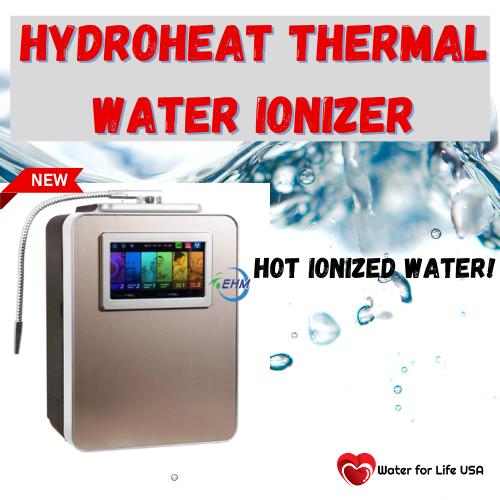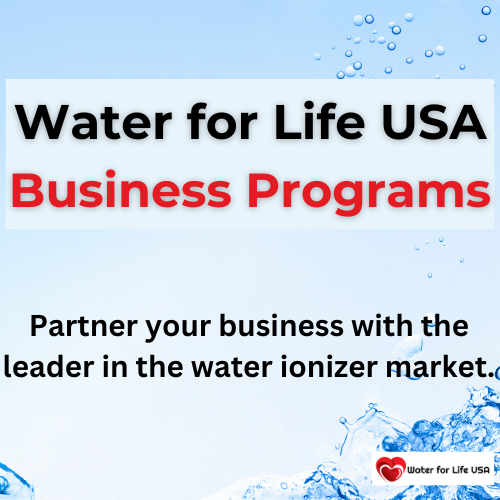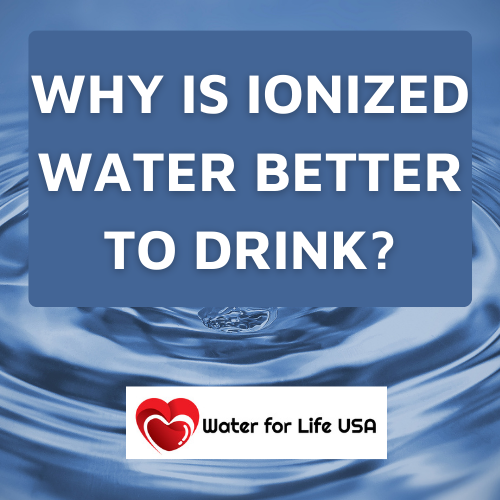Spring Sale! Save 20%

Celebrating 14 Years in Business and an A+ BBB Rating!
A water ionizer is an appliance that ionizes water through water electrolysis. It connects to your kitchen water supply to perform electrolysis on tap water before you drink it or use it in the kitchen for cooking or cleaning (1).
A special attachment, commonly called a faucet diverter valve, re-directs tap water out of the faucet through a plastic hose into the water ionizer. Inside the water ionizer the water is first filtered, usually through activated carbon, felt, and resin, depending on the design of the water ionizer manufacturer. Next, the filtered water passes into an electrolysis chamber equipped with a platinum-coated titanium electrode where electrolysis takes place.
Cations, positive ions, gather at the negative electrodes to create cathodic water (reduced water). Anions, negatively charged ions, gather at the positive electrode to make anodic water (oxidized water).
The reduced water comes out of the faucet, and the oxidized water comes out of a separate hose leading into the sink (1).
Ionized water (aka reduced water, electrolyzed water, antioxidant water) has different properties than non-ionized water.
First it is hydrogen-rich.“The existence of hydrogen particles as a colloid in electrolyzed water was elucidated both by the DLS method and by the two methods used for determining the hydrogen content. The difference between the hydrogen content obtained from the chemical analysis method and that obtained from the DH-meter is owing to the existence of hydrogen particles. Hydrogen particles whose diameters are below about 600 nm exist as a colloid. The diameter of hydrogen particles decreased with an increasing current density and an increasing sodium chloride concentration. (6)”
Secondly, ionized water is reduced. “Through electrolysis, reduced water not only gains an excess amount of electrons (e-), but the cluster of H2O seem to be reduced in size from about 10 to 13 molecules per cluster to 5 to 6 molecules per cluster.” (1)
Thirdly, ionized acidic water is oxidizing. “The efficacy of electrolyzed oxidizing water for inactivating Escherichia coli O157:H7, Salmonella enteritidis, and Listeria monocytogenes was evaluated. A five-strain mixture of E. coli O157:H7, S. enteritidis, or L. monocytogenes of approximately 108 CFU/ml was inoculated in 9 ml of electrolyzed oxidizing water (treatment) or 9 ml of sterile, deionized water (control) and incubated at 4 or 23°C for 0, 5, 10, and 15 min; at 35°C for 0, 2, 4, and 6 min; or at 45°C for 0, 1, 3, and 5 min. The surviving population of each pathogen at each sampling time was determined on tryptic soy agar. At 4 or 23°C, an exposure time of 5 min reduced the populations of all three pathogens in the treatment samples by approximately 7 log CFU/ml, with complete inactivation by 10 min of exposure. A reduction of >7 log CFU/ml in the levels of the three pathogens occurred in the treatment samples incubated for 1 min at 45°C or for 2 min at 35°C. The bacterial counts of all three pathogens in control samples remained the same throughout the incubation at all four temperatures. Results indicate that electrolyzed oxidizing water may be a useful disinfectant, but appropriate applications need to be validated (7).
Because ionized water is hydrogen –rich, it serves as an antioxidant in our bodies.
“When taken internally, the reduced Ionized Water with its redox potential of -250 to -350 mV readily donates its electrons to oddball oxygen radicals and blocks the interaction of the active oxygen with normal molecules. BM-e || MW-e + AO ——-à MW + AO-e . A biological molecule (BM) remains intact and undamaged.
Undamaged biological molecules are less susceptible to infection and disease. Ionized Water gives up an extra electron and reduces the active oxygen (AO), thus rendering it harmless. The AO is reduced without damaging surrounding biological molecules. Substances which have the ability to counteract active oxygen by supplying electrons are called scavengers. Reduced water, therefore, can be called scavenging water. (1)”
“Active oxygen species or free radicals are considered to cause extensive oxidative damage to biological macromolecules, which brings about a variety of diseases as well as aging. The ideal scavenger for active oxygen should be ‘active hydrogen’. ‘Active hydrogen’ can be produced in reduced water near the cathode during electrolysis of water. Reduced water exhibits high pH, low dissolved oxygen (DO), extremely high dissolved molecular hydrogen (DH), and extremely negative redox potential (RP) values. Strongly electrolyzed–reduced water, as well as ascorbic acid, (/)-catechin and tannic acid, completely scavenged O•02 produced by the hypoxanthine-xanthine oxidase (HX-XOD) system in sodium phosphate buffer (pH 7.0). The superoxide dis mutase (SOD)-like activity of reduced water is stable at 47C for over a month and was not lost even after neutralization, repeated freezing and melting, deflation with sonication, vigorous mixing, boiling, repeated filtration, or closed autoclaving…(5)”
“Reduced water had a tendency to suppress single-strand breakage of DNA induced by reactive oxygen species produced by H2O2yCu (II) and HQyCu (II) systems.The enhancement of superoxide anion radical dismutation activity can be explained by changes in the ionic product of water in the reduced water (2).”
“We reported that reduced water produced by electrolysis enhanced the antioxidant effects of proton donors such as ascorbic acid (AsA) in a previous paper.W e also demonstrated that reduced water produced by electrolysis of 2 mM NaCl solutions did not show antioxidant effects by itself. We reasoned that the enhancement of antioxidant effects may be due to the increase of the ionic product of water as solvent.The ionic product of water (pKw) was estimated by measurements of pH and by a neutralization titration method. As an indicator of oxidative damage, Reactive Oxygen Species- (ROS) mediated DNA strand breaks were measured by the conversion of supercoiled fX-174 RFI double-strand DNA to open and linear forms.Reduced water had a tendency to suppress single-strand breakage of DNA induced by reactive oxygen species produced by H2O2yCu (II) and HQyCu (II) systems.The enhancement of superoxide anion radical dismutation activity can be explained by changes in the ionic product of water in the reduced water. (18)”
“When taken internally, the effects of reduced water are immediate. Ionized Water inhibits excessive fermentation in the digestive tract by reducing indirectly metabolites such as hydrogen sulfide, ammonia, histamines, indoles, phenols and scatoles, resulting in a cleaner stool within days after reduced water is taken on a regular basis. (1)”
Because of the hydrogen-rich, reduced, and oxidizing qualities of ionized water, you can use the reduced water for drinking, cooking, or cleaning. “The oxidation potential of the oxidized water makes it a good sterilizing agent, ideal for washing hands, cleaning food or kitchen utensils, and treating minor wounds.” (1)
Oxidized water with its redox potential of +700 to +800 mV is an oxidizing agent that can withdraw electrons from bacteria and kill them. The oxidized water from the Ionized Water unit can be used to clean hands, kitchen utensils, fresh vegetables and fruits, and to sterilize cutting boards and minor wounds. Tests have shown that oxidized water can be used effectively to treat athlete’s foot, minor burns, insect bites, scratches, and so on (1).
Although hyperoxidized water is a powerful sterilizing agent, it won’t harm the skin. In fact, it can be used to heal. Hyperoxidized water has proven effective in Japanese hospitals in the treatment of bedsores and operative wounds with complicated infections (1).
But perhaps the most exciting future application of hyperoxidized water is in the field of agriculture where it has been used effectively on plants to kill fungi and other plant diseases. Hyperoxidized water is non-toxic, so agricultural workers can apply it without wearing special protective equipment because there is no danger of skin or respiratory damage. An added benefit of using hyperoxidized water to spray plants is that there is no danger to the environment caused by the accumulation of toxic chemicals in the ground (1).
Ionized Water, with its low molecular weight and high reduction potential, makes it a superior scavenging agent of active oxygen. But electrolysis inside the Ionized Water unit not only charges the reduced water with electrons, it also reduces the size of reduced water molecule clusters (1).
NMR (Nuclear Magnetic Resonance) analysis reveals that tap water and well water consists of clusters of 10 to 13 H20 molecules. Electrolysis of water in the Ionized Water unit reduces these clusters to about half their normal size — 5 to 6 water molecules per cluster. (1)”
Teliospores Sterilization: The US Military ran a study showing, “AEW (alkaline electrolyzed water) has certain advantages over NaOCl for surface sterilizing and increasing germination of teliospores of suspect T. indica. (9)
Salmanella Sterilization: “After 7 d of storage, TSP, AA, and EO-A water reduced ST 2.17, 2.31, and 1.06 log10, respectively. ST was reduced 2.11 log10 immediately following the multiple interventions, 3.81 log10 after 7 d of storage. Although effective against ST, TSP and AA are costly and adversely affect the environment.
This study demonstrates that EO water can reduce ST on poultry surfaces following extended refrigerated storage. (19)”
On Agriculture Application/ Reduction of Ecoli: “Electrolyzed oxidizing water is a relatively new concept that has been utilized in agriculture, livestock management, medical sterilization, and food sanitation. Electrolyzed oxidizing (EO) water generated by passing sodium chloride solution through an EO water generator was used to treat alfalfa seeds and sprouts inoculated with a five-strain cocktail of nalidixic acid resistant Escherichia coli O157:H7. EO water had a pH of 2.6, an oxidation-reduction potential of 1150 mV and about 50 ppm free chlorine. The percentage reduction in bacterial load was determined for reaction times of 2, 4, 8, 16, 32, and 64 min. Mechanical agitation was done while treating the seeds at different time intervals to increase the effectiveness of the treatment. Since E. coli O157:H7 was released due to soaking during treatment, the initial counts on seeds and sprouts were determined by soaking the contaminated seeds/sprouts in 0.1% peptone water for a period equivalent to treatment time. The samples were then pummeled in 0.1% peptone water and spread plated on tryptic soy agar with 5 microg/ml of nalidixic acid (TSAN). Results showed that there were reductions between 38.2% and 97.1% (0.22-1.56 log(10) CFU/g) in the bacterial load of treated seeds. The reductions for sprouts were between 91.1% and 99.8% (1.05-2.72 log(10) CFU/g). An increase in treatment time increased the percentage reduction of E. coli O157:H7. However, germination of the treated seeds reduced from 92% to 49% as amperage to make EO water and soaking time increased. EO water did not cause any visible damage to the sprouts. (20)”
Cutting Board Sterilization: “One milliliter of culture containing a five-strain mixture of Escherichia coli O157:H7 (approximately 10(10) CFU) was inoculated on a 100-cm2 area marked on unscarred cutting boards. Following inoculation, the boards were air-dried under a laminar flow hood for 1 h, immersed in 2 liters of electrolyzed oxidizing water or sterile deionized water at 23 degrees C or 35 degrees C for 10 or 20 min; 45 degrees C for 5 or 10 min; or 55 degrees C for 5 min. After each temperature-time combination, the surviving population of the pathogen on cutting boards and in soaking water was determined. Soaking of inoculated cutting boards in electrolyzed oxidizing water reduced E. coli O157:H7 populations by > or = 5.0 log CFU/100 cm2 on cutting boards. However, immersion of cutting boards in deionized water decreased the pathogen count only by 1.0 to 1.5 log CFU/100 cm2. Treatment of cutting boards inoculated with Listeria monocytogenes in electrolyzed oxidizing water at selected temperature-time combinations (23 degrees C for 20 min, 35 degrees C for 10 min, and 45 degrees C for 10 min) substantially reduced the populations of L. monocytogenes in comparison to the counts recovered from the boards immersed in deionized water. E. coli O157:H7 and L. monocytogenes were not detected in electrolyzed oxidizing water after soaking treatment, whereas the pathogens survived in the deionized water used for soaking the cutting boards.
This study revealed that immersion of kitchen cutting boards in electrolyzed oxidizing water could be used as an effective method for inactivating foodborne pathogens on smooth, plastic cutting boards (21).
Hospital Infection Sterilization
: “The study is designed to investigate bactericidal actions of electrolyzed oxidizing water on hospital infections. Ten of the most common opportunistic pathogens are used for this study. Cultures are inoculated in 4.5 mL of electrolyzed oxidizing (EO) water or 4.5 mL of sterile deionized water (control), and incubated for 0, 0.5, and 5 min at room temperature. At the exposure time of 30 s the EO water completely inactivates all of the bacterial strains, with the exception of vegetative cells and spores of bacilli which need 5 min to be killed. The results indicate that
electrolyzed oxidizing water may be a useful disinfectant for hospital infections
, but its clinical application has still to be evaluated. (22)”
Sterilization of Wound in Burns: “OBJECTIVE: To study the efficacy of electrolyzed oxidizing water (EOW) and hydrocolloid occlusive dressings in the acceleration of epithelialization in excised burn-wounds in rats.
METHODS: Each of the anesthetized Sprague-Dawley rats (n=28) was subjected to a third-degree burn that covered approximately 10% of the total body surface area. Rats were assigned into four groups: Group I (no irrigation), Group II (irrigation with physiologic saline), Group III (irrigation with EOW) and Group IV (hydrocolloid occlusive dressing after EOW irrigation). Wounds were observed macroscopically until complete epithelialization was present, then the epithelialized wounds were examined microscopically. RESULTS: Healing of the burn wounds was the fastest in Group IV treated with hydrocolloid occlusive dressing together with EOW. Although extensive regenerative epidermis was seen in each Group, the proliferations of lymphocytes and macrophages associated with dense collagen deposition were more extensive in Group II, III and IV than in Group I. These findings were particularly evident in Group III and IV.
CONCLUSIONS: Wound Healing may be accelerated by applying a hydrocolloid occlusive dressing on burn surfaces after they are cleaned with electrolyzed oxidating water (23).
Extending life of cut flowers: “Electrolyzed anode water (EAW) markedly extended the vase life of cut carnation flowers. Therefore, a flower-senescence hormone involving ethylene decomposition by EAW with potassium chloride as an electrolyte was investigated. Ethylene was added externally to EAW, and the reaction between ethylen and the available chlorine in EAW was examined. EAW had a low pH value (2.5), a high concentration of dissolved oxygen, and extremely high redox potential (19.2 mg/l and 1323 mV, respectively) when available chlorine was at a concentration of about 620 microns. The addition of ethylene to EAW led to ethylene decomposition, and an equimolar amount of ethylene chlorohydrine with available chlorine was produced. The ethylene chlorohydrine production was greatly affected by the pH value (pH 2.5, 5.0 and 10.0 were tested), and was faster in an acidic solution. Ethylene chlorohydrine was not produced after ethylene had been added to EAW at pH 2.6 when available chlorine was absent, but was produced after potassium hypochlorite had been added to such EAW. The effect of the pH value of EAW on the vase life of cut carnations was compatible with the decomposition rate of ethylene in EAW of the same pH value.
These results suggest that the effect of Electrolyzed Anode Water on the vase life of cut carnations was due to the decomposition of ethylene to ethylene chlorohydrine by chlorine from chlorine compounds (24).
Muchresearch has been conducted used alkaline, ionized water. While most of it is conducted on lab animals, some has been conducted on humans, such as renal failure patients. This is a very small sampling. To see more research, please search for “electrolyzed” water on the Google Scholarly website.
“Osteoporosis that has lately drawn public attention is defined as “conditions of bone brittleness caused by reduction in the amount of bone frames and deterioration of osseous microstructure.” Abnormal calcium metabolism has been considered to be one of the factors to contribute to this problem, which in turn is caused by insufficient calcium take-in, reduction in enteral absorption rate of calcium and increase in the
amount of calcium in urinal discharge. Under normal conditions, bones absorb old bones by regular metabolism through osteoid formation to maintain their strength and function as supporting structure. It is getting clear that remodelling of bones at the tissue level goes through the process of activation, resorption, reversal, matrix synthesis and mineralization. Another important function of bones is storing minerals especially by coordinating with intestines and kidneys to control calcium concentration in the blood. When something happens to this osteo metabolism, it results in abnormal morphological changes. Alkaline ionized water was regarded to be effective for improvements of osteogenesis under the conditions of insufficient calcium in the feed. Also, the extent of
dysosteogenesis differed by the region. That is, tibiae and humeri tend to have more significant dysosteogenesis than femora.
In addition, there is a possibility that osteo metabolism varies depending on enteral absorption rate of calcium, adjustment of discharge from kidneys and functional adjustment of accessory thyroid in the presence of alkaline ionized water. (8)”
“…These results suggest that RW protects pancreatic β-cells from alloxan-induced cell damage by preventing alloxan-derived ROS generation. RW may be useful in preventing alloxan-induced type 1-diabetes mellitus. (3)”
“Reactive oxygen species (ROS) cause irreversible damage to biological macromolecules, resulting in many diseases. Reduced water (RW) such as hydrogen-rich electrolyzed reduced water and natural reduced waters like Hita Tenryosui water in Japan and Nordenau water in Germany that are known to improve various diseases, could protect a hamster pancreatic β cell line, HIT-T15 from alloxan-induced cell damage. Alloxan, a diabetogenic compound, is used to induce type 1 diabetes mellitus in animals. Its diabetogenic effect is exerted via the production of ROS. Alloxan-treated HIT-T15 cells exhibited lowered viability, increased intracellular ROS levels, elevated cytosolic free Ca2+ concentration, DNA fragmentation, decreased intracellular ATP levels and lowering of glucose-stimulated release of insulin. RW completely prevented the generation of alloxan-inducedROS, increase of cytosolic Ca2+ concentration, decrease of intracellular ATP level, and lowering of glucose-stimulated insulin release, and strongly blocked DNA fragmentation, partially suppressing the lowering of viability of alloxan-treated cells.
Intracellular ATP levels and glucose-stimulated insulin secretion were increased by RW to 2–3.5 times and 2–4 times, respectively, suggesting that RW enhances the glucose-sensitivity and glucose response of β-cells. The protective activity of RWwas stable at 4 ◦C for over a month, but was lost by autoclaving. These results suggest that RW protects pancreatic β-cells from alloxan-induced cell damage by preventing alloxan-derived ROS generation. RW may be useful in preventing alloxan-induced type 1-diabetes mellitus. (3)”
We have found that long-term ingestion of alkaline ionized water (AIW) reduces cercal fermentation in rats that were given highly fermentable commercial diet (MF: Oriental Yeast Co., Ltd.). In this experiment, rats were fed MF and test water (tap water, AIW with pH at 9 and 10) for about 3 months.
Faeces were collected on the 57th day, and the rats were dissected on the 88th day. The amount of ammonium in fresh faces and cecal contents as well as faecal free-glucose tended to drop down for the AIW group.
In most cases, the amount of free-amino acids in cecal contents did not differ significantly except for cysteine (decreased in AIW with pH at 10) and isoleucine (increased in AIW with pH at 10). (4)
Certain minerals can produce alkaline reduced water with high pH and low oxidation-reduction potential (ORP) when dissolved in water. Alkaline reduced water (ARW) showed significant anticancer effect. When B16 melanoma cells were inoculated subcutaneously and intra-peritoneally, C56BL/6 mice fed with ARW showed tumor growth delay and the survival span was significantly lengthened. ARW also showed the inhibition of metastasis by reducing the numbers of B16 melanoma colonies when injected through tail vein.
The amount of reactive oxygen species (ROS) was very reduced when fed with ARW except for spleen, which is a major organ for immunity. Even for normal mice, ARW intake invoked systemic cytokines, such as, Th1 (IFN-IL-12) and Th2 (IL-4, IL-5), suggesting strong immuno-modulation effect. Both ROS scavenging effect and immuno-modulation effect might be responsible for anticancer effect of alkaline reduced water. (11)
Renal failure is accompanied by oxidative stress, which is caused by enhanced production of reactive oxygen species and impaired antioxidant defense. The suggested therapeutical interventions aimed at reducing oxidative stress in >chronic renal failure patients are as follows: 1) the use of biocompatible membranes, ultrapure dialysate, and removal of endogenous foci of infection; 2) haemolipodialysis, and electrolysed reduced water for dialysate preparation; 3) administration of antioxidants ( -tocopherol, ascorbic acid, N-acetylcysteine, reduced glutathione); 4) substances possibly affecting oxidative stress indirectly (erythropoietin, sodium selenite). As currently available data have, as yet, provided rather limited evidence for the clinical benefit of antioxidant interventions, at present it is untimely to give practical recommendations with regard to antioxidant treatment of patients with renal failure (10).
Gynecological: “Ionized alkaline antioxidant water improves body constituents and ensures effective healing to many illnesses. The uses of antioxidant water in gynecological patients have proved to be very effective. The main reason for its effectiveness is that this water can neutralize toxins.
When given antioxidant water to pre-eclamptic toxemia cases, the results are most significant. During my long years of servicing the pre-eclamptic toxemia cases, I found that the women with pre-eclamptic toxemia who consumed antioxidant water tend to deliver healthier babies with stronger muscles
. A survey report carried out on babies in this group showed intelligence above average. (25)”
Effects on Cholesterol: “Too many fats in the diets, which lead to the deposition of cholesterol on the blood vessels, which in turn constrict the blood flow, cause most illnesses such as high blood pressure. In accordance with the theory of Professor Gato of Kyushu University on Vitamin K (because vitamin K enables the blood calcium to increase ), or the consumption of more antioxidant water, the effectiveness of the increase in the calcium in high blood pressure is most significant. With the consumption of alkaline antioxidant water for a period of 2 to 3 months, I have observed the blood pressure slowly drop, due to the water’s solvent ability, which dissolves the cholesterol in the blood vessels. (26)”
Neutralize Toxins: “In my opinion, the wonder of antioxidant water is the ability neutralizes toxins, but it is not a medicine. The difference is that the medicine can only apply to each and individual case, whereas the antioxidant water can be consumed generallyand its neutralizing power is something which is very much unexpected. Now, in brief, let me introduce to you a heart disease case and how it was cured.
The patient was a 35 years old male suffering from vascular heart disease. For 5 years, his sickness deteriorated. He was in the Setagays Government Hospital for treatment.
During those 5 years, he had been in and out of the hospital 5 to 6 times. He had undergone high tech examinations such as angiogram by injecting VINYL via the vein into the heart. He consulted and sought treatment from many good doctors where later he underwent a major surgical operation. Upon his discharge from the hospital, he quit his job to convalesce. However, each time when his illness relapsed, the attack seemed to be even more severe.
Last year, in August, his relatives were in despair and expected he would not live much longer. It so happened at that time that the victim’s relative came across an antioxidant alkaline water processor… His illness responded well and he is now on the road to recovery.”
In the United States, cardiovascular diseases account for more than one-half of the approximate 2 million deaths occurring each year. It is estimated that optimal conditioning of drinking water could reduce this cardiovascular disease mortality rate by as much as 15 percent (27).”
Eczema: “Eczema is used to describe several varieties of skin conditions, which have a number of common features. The exact cause or causes of eczema are not fully understood. In many cases, eczema can be attributed to external irritants.
Let me introduce a patient who recovered from skin disease after consuming the antioxidant water. This patient suffered 10 years of eczema and could not be cured effectively even under specialist treatment. This patient, who is 70 years of age, is the president of a vehicle spare parts company. After the war, his lower limbs suffered acute eczema, which later became chronic. He was repeatedly treated in a specialist skin hospital.
The left limb responded well to treatment, but not so on the right limb. He suffered severe itchiness, which, when scratched led to bleeding. During the last 10 years, he was seen and treated by many doctors. When I first examined him, his lower limb around the joints was covered with vesicles. Weeping occurred owing to serum exuding from the vesicles.
I advised him to try consuming antioxidant water. He bought a unit and consumed the antioxidant water religiously and used the acidic water to bathe the affected areas. After 2 weeks of treatment the vesicles dried up. The eczema completely cleared without any relapse after 1½ month. (28)”
Allergies: “Mr. Yamada, the head of the Police Research Institute, suffered from severe allergy. He was treated repeatedly by a skin specialist, but with no success. Then he started consuming antioxidant water. The allergy responded very well and was soon completely cured. No relapse had occurred, although he had taken all kinds of food. He was most grateful and excited about this treatment.
As for myself, I had also suffered severe allergy. From the time I began to consume antioxidant water, the allergy has not returned. Since then, I started research on the effectiveness of antioxidant water.
I discovered that most allergies are due to acidification of body condition and is also related to consuming too much meat and sugar. In every allergy case, the patient’s antioxidant minerals are excessively low which in turn lower the body resistance significantly. The body becomes overly sensitive and develops allergy easily. To stabilize the sensitivity, calcium solution in injected into the vein. Therefore, it is clear that antioxidant water, with ionic calcium, can help alleviate allergy.
The ionic calcium not only enhances the heart, urination, and neutralization of toxins but controls acidity. It also enhances the digestive system and liver function. This will promote natural healing power and hence increase its resistance to allergy. In some special cases of illness, which do not respond to drugs, they are found to respond well to antioxidant water.” (29)
Diabetes: “When I was serving in the Fire Insurance Association, I used to examine many diabetic patients. Besides treating them with drugs, I provided them with antioxidant water. After drinking antioxidant water for one month, 15 diabetic patients were selected and sent to Tokyo University for further test and observations.
Initially, the more serious patients were a bit apprehensive about the treatment. When the antioxidant water was consumed for some time, the sugar in the blood and urine ranged from a ratio of 300 mg/l to 2 mg / dc. There was a time where the patients had undergone 5 to 6 blood tests a day and detected to be within normal range. Results also showed that even 1 ½ hour after meals, the blood sugar and urine ratio was 100 mg/dc: 0 mg/dc . The sugar in the urine had completely disappeared.
NOTE:
More Americans than ever before are suffering from diabetes, with the number of new cases averaging almost 800,000 each year. The disease has steadily increased in the United States since 1980, and in 1998, 16 million Americans were diagnosed with diabetes (10.3 million diagnosed; 5.4 million undiagnosed). Diabetes is the seventh leading cause of death in the United States, and more than 193,000 died from the disease and its related complication in 1996.” (30)
Obesity: “Due to a higher standard of living, our eating habits have changed. We consume too much proteins, fats and sugar. The excess fats and carbohydrates are in the body as fats. In the present lifestyles, Americans are more extravagant on food compared to the Japanese. Due to this excessive intake obesity is a significant problem. Normally, one out of five males and one out of four females is obese.
The degree of “burn-out” in food intake largely depends on the amount on intake of vitamins and minerals. When excessive intake of proteins, carbohydrates and fats occurs, the requirement for vitamins and minerals increases. However, there is not much research carried out pertaining to the importance of vitamins and minerals.
Nowadays, many people suffer from acidification that leads to diabetes, heart diseases, cancer, liver and kidney diseases. If our food intake can be completely burned off, then there is no deposition of fats. Obviously, there will be no acidification problem and hence there should not be any sign of obesity.
The antioxidant water contains an abundance of ionic calcium. This ionic calcium (and other alkalizing minerals) help in the “burn-off” process. By drinking antioxidant water, it provides sufficient minerals for our body.
Hence, antioxidant water is a savior for those suffering from obesity and many adult diseases, providing assistance in enhancing good health.” (31)
Water ionizers were first developed in Japan in the early 1950’s, and the experiments were first conducted on plants and animals. Full scale development started in 1954 by several Japanese agricultural universities on the effects of ionized water, especially acid water, on plants (17).
Experiments on the human body took much longer because of the difficulties in maintaining the constancy of the experiments by the medical doctors in Japan, valuable data has been collected and it was concluded that alkaline water made by the water ionizer was non-toxic and alleviated many symptoms of adult diseases (17).
The first commercial water ionizers were available in Japan in 1958. Until then, the only water ionizer available was large units used in hospitals. In 1960, a group of medical doctors and agricultural doctors in Japan formed a special medical and agricultural research institute, and they have annual meetings to report their findings. Finally, on January 15th, 1966, this type of water ionizer was approved as a health improvement medical device by the Health and Rehabilitation Ministry of the Japanese Government (17).
Japanese-made water ionizers were first introduced to Korea in the 70’s, and today they are also approved as medical devices by the government of South Korea. Korean-made household unit water ionizers were introduced in the United States in 1985 and a toxicity test was conducted by an independent testing lab in LA on April 14, 1986. The professional research in Taiwan have been continuing for more than 30 years and improving the water ionizer’s manufacturing skill as well as the high performance of electrolysis. Taiwanese computer techniques are leading in the world as well as the new system for water ionizer. Taiwanese products has introduced in North America and Asia in 2003, also been recognized by most advance device in markets. The world largest electrolysis chamber counter top model performs professional requirement. The test found no toxicity in the alkaline water generated by the water ionizer. This testing was done according to FDA specified methods (17).
There are a couple authors that state water ionizers can’t ionize water or that ionized water has no benefits to humans when consumed. The previous author of this Wikipedia page stated “Although there is no empirical evidence that ionized water is beneficial to human health, it is marketed with claims that it is an antioxidant and can slow aging and prevent disease.[12] Such claims contradict basic laws of chemistry and physiology.[13]”
The author cites an abstract of a Los Angeles Times article (not the article itself), where one Mr. Thomas Wheeler suggests that “any negative ions you drink would immediately bind with positive ions. And even if the negative ions stuck around, they could never act as antioxidants or attack free radicals. The body relies on molecules like vitamin E and beta carotene for antioxidants. The idea that you could just drink extra electrons is ridiculous.”
However, ionized water is hydrogen-rich (6), which has clearly been shown to be an effective antioxidant in a number of peer-reviewed research articles (please see “Antioxidant Qualities of Ionized Water”). Peer reviewed research articles have much higher standards for publication than an article in the Los Angeles Times.
Secondly, the previous author of this Wikipedia page states, “There is no empirical evidence to support claims made by manufacturers that drinking ionized water will have a noticeable effect on the body.[4]” He cites Brain Dunning, the author of a blog website (14). Brian Dunning is not a researcher, doctor, has no direct experience with water ionizers and the only citation he uses is another website run by former chemist Stephen Lower (13).
On Stephen Lower’s website, he states:
“Ionized”/alkaline water is falsely claimed to be an anti-oxidant.”
“Electrolysis devices are generally worthless for treating water for health enhancement, removal of common impurities, disinfection, and scale control.”
“Pure water can never be alkaline or acidic, nor can it be made so by electrolysis. Alkaline water must contain metallic ions of some kind — most commonly, sodium, calcium or magnesium.”
“Ionized water” is nothing more than sales fiction; the term is meaningless to chemists.”
“Pure water (that is, water containing no dissolved ions) is too unconductive to undergo signficant electrolysis by “water ionizer” devices.”
Research has been done showing ionized water as hydrogen rich and reduced (1,2,3,4) and with positive health benefits for humans (
These skeptics have not conducted scientific studies on water ionizers or ionized water. Their opinions don’t meet the standards of peer reviewed research, demonstrated in this article.
1) Hayashi, Hidemitsu. “Ionized Water: What is It?”www.anti-aging-today.org. Retrieved 2011-10-7.
2) K. Hanaoka et al. (2004) “The mechanism of the enhanced antioxidant effects against superoxide anion radicals of reduced water produced by electrolysis.” Biophysical Chemistry 107 71–82. Retrieved 2011-10-7..
3) L. Yuping et al. (2002) “Protective mechanism of reduced water against alloxan-induced pancreatic β-cell damage: Scavenging effect against reactive oxygen species.”Cytotechnology 40: 139–149, 2002. Retrieved 2011-10-7.
4) T. Takiawa et al. (3/21/1997) “Physiological effects of alkaline ionized water:
Effects on metabolites produced by intestinal fermentation.” Gifu University, Faculty of Engineering, Dept. of Food Science. Retrieved 2011-10-7.
5) S. Shirahata et al. (1997) “Electrolyzed–Reduced Water Scavenges Active Oxygen Species and Protects DNA from Oxidative Damage.” BIOCHEMICAL AND BIOPHYSICAL RESEARCH COMMUNICATIONS 234, 269–274 ARTICLE NO. RC976622. Retrieved 10/7/2011.
6) K. Kiuchi et al. (3/21/2001) “Hydrogen particles and supersaturation in alkaline water from an Alkali–Ion–Water electrolyzer.” Journal of Electroanalytical Chemistry 506 22–27. Retrieved 2011-10-7.
7) S. Kumar et al. (9/2009)“Efficacy of Electrolyzed Oxidizing Water for Inactivating
Escherichia coli O157:H7, Salmonella enteritidis, and Listeria monocytogenes.” APPLIED AND ENVIRONMENTAL MICROBIOLOGY, 0099-2240/99/$04.0010 Sept. 1999, p. 4276–4279. Retrieved 2011-10-7..
8) R. Takahashi et al. “Effects of calcium alkaline ionized water on formation and maintenance of osseous tissues (osteoporosis).” Rei Takahashi, Zhenhua Zhang, Yoshinori ItokawaKyoto University Graduate School of Medicine, Dept. of Pathology and Tumor Biology, Fukui Prefectural University,Japan. Retrieved 2011-10-7.
9) M. Bonde et al. (1999). “Comparison of effects of acidic electrolyzed water and NaOCl on Tilletia indica teliospore germination.” USDA-ARS, Foreign Disease-Weed Science Research Unit, Fort Detrick, MD 21702-5023;Plant Dis. 83:627-632. Retrieved 2011-10-7.
10) Luciak, M. (2004) “Antioxidants in the treatment of patients with renal failure.” .Roczniki Akademii Medycznej w Białymstoku · Vol. 49, 2004. Retrieved 2011-10-7.
11)L. Kyu-jae et al.“Anticancer Effect of Alkaline Reduced Water.”Dept. of Parasitology, Institute of Basic Medical Sciences, Dept. of Microbiology, Dept. of Biochemistry, Wonju College of Medicine, Yonsei Univ. Dept. of Biomedical Laboratory Science and Institute of Health Science, College of Health Science, Yonsei Univ. Retrieved 2011-10-7.
12) Woolston, Chris (2007-01-22). “It’ll quench your thirst, of course. But whether ionized water can slow aging and fight disease is another matter”. Los Angeles Times. Retrieved 2011-10-7..
13) Lower, S. “”Ionized” and alkaline water: Snake oil on tap”. Retrieved 2011-10-7..
14) University of Illinois, Dept. of Chemistry (2008-10-28). “Electrolysis of water using an electrical current”. Retrieved 2011-10-7.
15) Brian Dunning (2009-02-03). “Change Your Water, Change Your Life”. Retrieved 2011-10-7.
16) Hricova D, Stephan R, Zweifel C. (2008). “Electrolyzed water and its application in the food industry.”. Journal of Food Protection 71 (9): 19–26. PMID 18810883. Retrieved 2011-10-7.
17) Whang, S. (2005). “Reverse Aging.” Miami: Florida, JSP Publishing, 73. Retrieved 2011-10-7.
18) K. Hanaoka et al. (2004). “The mechanism of the enhanced antioxidant effects against superoxide anion radicals of reduced water produced by electrolysis.”Biophys Chem. 2004Jan 1;107(1):71-82. Retrieved 2011-10-7.
19) K. Fabrizio et al. (2002-10). ”Comparison of electrolyzed oxidizing water with various antimicrobial interventions to reduce Salmonella species on poultry.” Poultry Science 2002 Oct;81(10):1598-605. Retrieved 2011-10-7.
20) K. Venkitanarayanan et al. “Inactivation of Escherichia coli (O157:H7) and Listeria monocytogenes on plastic kitchen cutting boards by electrolyzed oxidizing water.”Department of Animal Science, University of Connecticut. Retrieved 2011-10-7.
21) Department of Agricultural and Biological Engineering. (2003). “Treatment of Escherichia coli (O157:H7) inoculated alfalfa seeds and sprouts with electrolyzed oxidizing water.” International Journal of Food Microbiology.2003 Sep 15;86(3):231-7. Retrieved 2011-10-7.
22) N. Vorabjeva et al. (2004) “The bactericidal effects of electrolyzed oxidizing water on bacterial strains involved in hospital infections.” Artif Organs.
2004 Jun;28(6):590-2.Retrieved 2011-10-7.
23) H. Xin et al. (2003) “Effect of electrolyzed oxidizing water and hydrocolloid occlusive dressings on excised burn-wounds in rats.” Chin J Traumatol 2003 Aug 1;6(4):234-7. Retrieved 2011-10-7.
24) K Harada et al. (2003) “Decomposition of ethylene, a flower-senescence hormone, with electrolyzed anode water.” Bioscience Biotechnololgy Biochemistry. 2003 Apr;67(4):790-6. Retrieved 2011-10-7.
25) Watanabe, I. “Use of Ionized water for gynecological conditions.” Watanabe Hospital, Japan. Retrieved 2011-10-7.
26) Hironage, K. “Use of Ionized water in hypochlorhydria or achlorhydria and reducing cholesterol.” Kuninaka Hospital, Japan. Retrieved 2011-10-7.
27) Keijiroo, K. (1977). “Alkaline Water used to Neutralized Toxins.” Report of the Safe Drinking Water Committee of the National Academy of Sciences. Retrieved 2011-10-7.
28) Tatsuji, T. “Alkaline Water and Eczema.”Keifuku Rehabilitation Center, Japan. Retrieved 2011-10-7.
29) Hironaga, K. “Alkaline Water for Allergy Treatment.”Kuninaka Hospital, Japan. Retrieved 2011-10-7.
30) Keizou, K. “Alkaline Water and Stomach Disease.”Clinic of Juntendo Hospital, Japan. Retrieved 2011-10-7.
31) Keijiroo, K. “Alkaline Water for Diabetes.”Retrieved 2011-10-7.

Save 20% on NEW water ionizers during our Spring Sale! Use code Spring20.

Get HOT ionized water! That's just one of the amazing new features of our HydroHeat Thermal Water Ionizer.

Generous wholesale discounts and drop-shipping available. If you run a health-centered or water-centered business, we want you! Please send us an email that introduces your business to info@waterforlifeusa.com or call us at 877-255-3713.

Confused about pH? Want to know the pH of milk? Or bananas? Or soda? Download this free easy-to-use pH Solutions chart. Just click on the graphic above.

Reverse osmosis? Carbon filter? Distiller? Find out why a water ionizer is better! Join Alderin Ordell, owner of Water for Life USA, as he explains pH, ORP, antioxidants in water, the history of water ionizers, and even what the experts have to say about the health benefits of ionized water.

We offer in-house payment plans. They require a 50% down payment and the rest is paid in three monthly installments. Call 877-255-3713 for more information.


Water for Life USA now has Apple Pay available for all purchases. Order with confidence using Apple Pay!
"Since I haven't been to a doctor in a good while, I decided to go and visit him. I was down 37
pounds and my blood pressure, heart rate, and body temperature were well within range. He
told me the last time I went to see him to get bl...